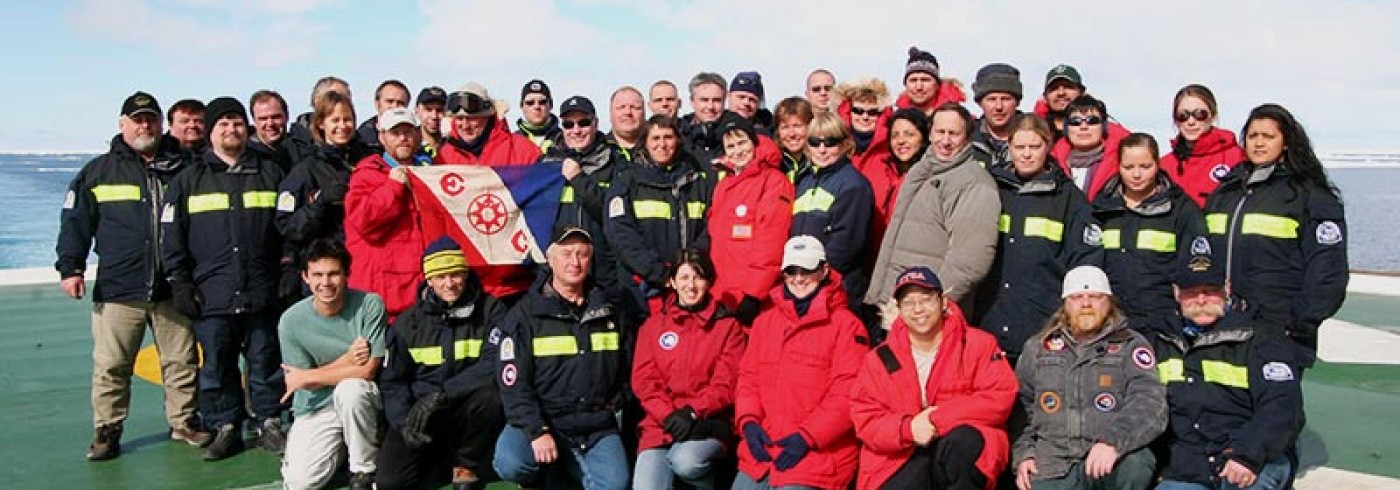Ship-based observations and remotely sensed data for the evaluation of the carbon dioxide system in the Southern Ocean
5 December 2006 - 25 December 2006
The variability of salinity (S), sea surface temperature (SST, °C), chlorophyll a fluorescence (chl, μg/L) and oxygen (μmol/kg) along the cruise track. Indications (dotted lines) show the approximate locations of the Sub Antarctic Zone (SAZ), Polar Zone (PZ), Marginal Ice Zone (MIZ) and the Ross Sea Polynya (RP) along the cruise track.
Aim
The overall aim for the proposed project is to evaluate algorithms with multiple regression for the estimation of surface water CO2 using remotely sensed data together with ship-based measurements of chlorophyll a, oxygen, sea surface temperature and the fugacity of CO2 in the surface water (fCO2, collaboration with Dr. Fransson). Thus, the project will give relevant information on the feedback processes affecting the air–sea CO2 flux, and provide necessary insight into how a changing environment may alter the carbon cycle in the Southern Ocean.
Background
Recent climate assessment reports (IPCC, ACIA) have shown that the high-latitude oceans are particularly sensitive to global warming caused by the increased content of greenhouse gases in the atmosphere induced by anthropogenic activities. Polar oceans, such as the seas surrounding Antarctica, play a role as sinks of atmospheric carbon dioxide. However, little is known regarding the temporal and spatial variability of the processes driving the CO2 system due to a lack of data coverage. Remotely sensed data provides an unprecedented sampling coverage and satellite borne sensors provide near synoptic global coverage of parameters such as wind speed over the ocean, sea surface temperature, and chlorophyll.
Methods and approach
Measurements on chlorophyll a (chl) fluorescence, dissolved oxygen (O2), sea surface temperature (SST) and salinity (S) were performed underway every minute from 14 to 26 December 2006 from Punta Arenas, Chile to the Ross Sea, Antarctica onboard the icebreaker Oden. Surface seawater samples (~90 samples) were also taken for the determination of nutrients (phosphate, nitrate, silicic acid), total dissolved inorganic carbon (CT) and total alkalinity (AT). These samples were preserved for post-cruise analyses at the Department of Chemistry, Göteborg University in March 2007.
Remotely-sensed chlorophyll a (chl) data provided by NASA, based on the merged product from MODIS and SeaWiFS, was downloaded after the cruise and will be compared with ship-based measured chlorophyll and on-line fluorescence for verification and algorithm development. The chlorophyll a fluorescence sensor (Minitracka II) was checked and calibrated against filtered and extracted chlorophyll a after the cruise.
Preliminary results
During our transit across the Drake Passage, the oxygen concentration (O2) increased gradually (figure 1), which was probably due to the effect of increased solubility as the salinity and temperature decreased (figure 1). In the Sub Antarctic Zone (SAZ) the chlorophyll a fluorescence (chl) was generally low and between 0 and 1 μg/l. Dramatic changes were observed as we entered the Polar frontal Zone (PZ), where the chl and O2 drastically increased, which suggests that the ship passed through several phytoplankton blooms in this area. Chl and oxygen concentrations decreased in the Marginal Ice Zone (MIZ), indicating less biological production. However, in the MIZ, we passed through large areas where the sea ice was green-brown coloured, thus implying extensive sea ice algae production, which could not be captured by underway measurements at a depth of 8 m. Polynyas are known to be sites for high biological activity, and in the Ross Sea Polynya (RP), we found maximum chl values of about 10 μg/l coinciding with the highest oxygen concentrations of 400 μmol/kg found along the cruise track (figure 1). Antarctic Zone (SAZ) the chlorophyll a fluorescence (chl) was generally low and between 0 and 1 μg/l. Dramatic changes were observed as we entered the Polar frontal Zone (PZ), where the chl and O2 drastically increased, which suggests that the ship passed through several phytoplankton blooms in this area. Chl and oxygen concentrations decreased in the Marginal Ice Zone (MIZ), indicating less biological production. However, in the MIZ, we passed through large areas where the sea ice was green-brown coloured, thus implying extensive sea ice algae production, which could not be captured by underway measurements at a depth of 8 m. Polynyas are known to be sites for high biological activity, and in the Ross Sea Polynya (RP), we found maximum chl values of about 10 μg/l coinciding with the highest oxygen concentrations of 400 μmol/kg found along the cruise track (figure 1).


